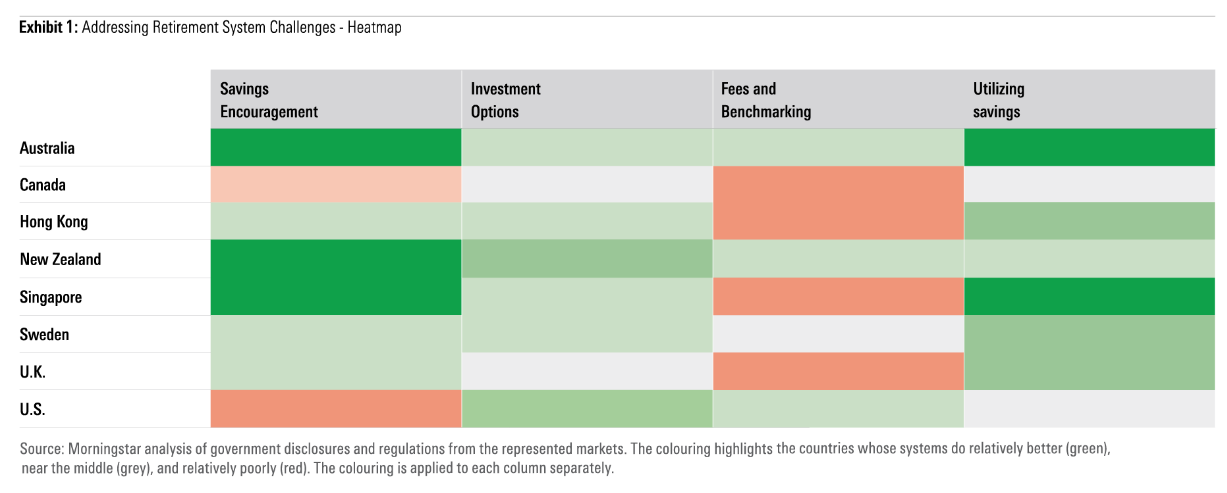
Investors in many markets are facing a common challenge: increasing responsibility for building savings to meet their needs in retirements that are lasting longer.
The fuel behind this fire comes from multiple sources: public or social security pensions often provide no more than a basic retirement income, fewer companies are offering defined benefit schemes to their workforce, and people are simply living longer.
Most countries operate some form of a three-pillar retirement framework:
- A social security pillar;
- Occupational- or workplace-related savings; and
- Personal or individual savings.
Optimising each of the pillars and their interaction is crucial to ensuring positive retirement outcomes.
In a new paper, we specifically examine the second pillar and the workplace retirement systems in eight countries spanning the Americas, Europe, and Asia.
The countries—The UK, Australia, Canada, Hong Kong, New Zealand, Singapore, Sweden, and the United States—all have effective retirement systems often cited in independent studies as among the best-in-class frameworks in their regions.
Rather than attempting to rank them based on differences, which might overly emphasise one approach, we have elected to observe and highlight both best practices and areas for improvement across four key components, illustrating these visually in a heatmap.

The UK: An Improving Regulatory Framework
As the portion of the population saving through defined contribution schemes continues to grow, regulators have increased focus on this market, proposing and implementing many features to improve access and outcomes.
On the savings front, regulatory efforts are bearing fruit with all employers required to offer workplace schemes and auto-enrolment mandatory going on 10 years. Employer and employee contributions are mandatory, unless an employee opts out, and employers can use matching formulas above their minimum required contribution rate to encourage employees to save more. Fragmentation of accounts can be a challenge for employees when changing jobs, although proposed regulation would address this with a participant dashboard in 2024.
When it comes to investment options, there is often an overabundance of options for employees. In the face of this, many employees who are auto-enroled will stay in the default fund. One challenge with this is that the common defaults of balanced funds and lifecycle programs are designed to suit a broad range of people but may not be perfectly suited for many of them.
As for fees, the UK imposes a fee cap on investments selected as the default, but this has largely resulted in funds clustering around the top with little downward pressure building. While employees are provided with fee and performance information for all the funds available to them, UK regulators are evaluating further specifications for pension providers to monitor and inform whether and how their schemes are offering value for money to their members.
In terms of utilisation of savings, assets in workplace schemes are largely inaccessible prior to near-retirement. An area of strength for the UK system is the free advice service available to those approaching retirement to help with planning the decumulation phase. Recent rules emphasise this service by all but requiring retirees to utilize it before allowing for a withdrawal.
Move to DC Plans Highlights Individual Responsibility
We find the DC scheme is already thriving in some markets and at a more embryonic stage in others. This is shaped by the extent to which social security pension schemes provide, or historically provided, a significant proportion of people's retirement income.
A key tenet of the move to DC is that investment risk is put squarely on individuals. On top of that, workers must navigate a complex web of rules and options to optimise their savings. Getting unconflicted fiduciary advice to workers and retirees cost-effectively is a resulting challenge still eluding most countries.
How Much Choice is Too Much?
While choice is good for experienced investors, too much choice is counterproductive, particularly for inexperienced investors. Some countries are better than others at optimising plan choices so that participants are more likely to select a high-quality, low-fee investment or be defaulted into such an option.
In the same way that workers can be faced with too much choice within a plan, it’s also easy for them to accumulate multiple workplace plans and for that fragmentation to erode their savings. Minimising the number of separate plans that individual workers have helps lowers costs and increases engagement. Countries have tried various approaches such as plan-follows-member, consolidating legacy plans into a "paid-up" plan, and auto-transferring small, orphaned plans to an individual’s current or central plan.
How Countries Aim to Get People Saving Earlier
In the countries that have adopted them, auto-enrolment programs have been very effective at getting more people saving earlier. Plus, incremental changes to the programs continue to enhance the experience of more workers. We find a growing number of examples seeking to engage members as retirement approaches but a dearth of initiatives to engage younger people in retirement saving.
The long-term nature of retirement saving can paradoxically create a savings disincentive for workers deterred by introducing a barrier to accessing their savings. Some countries alleviate this to different degrees by allowing early access to retirement savings in certain circumstances, but there is a delicate balance between this and preventing people depleting their retirement income by using too much for other purposes.
In the UK, the introduction of the Lifetime ISA in 2016 was heralded as a way to attract young people to a flexible savings model they could use to fund either home ownership or retirement, but that came to the chagrin of policy experts who had spent over a decade establishing a consensus over auto-enrolment.
Reducing Complexity
A common challenge we observed across heterogeneous retirement frameworks is complexity. They generally operate within complex rules and offer investment options that are not necessarily intuitive to inexperienced investors. Together, these factors make it challenging to ascertain how best to both accumulate, and then decumulate, retirement savings.
Overall, the hallmarks of the best-placed workplace schemes are government-mandated contributions; savings incentives, such as tax breaks or government contributions and employer-contribution-matching programs; and transparent oversight or benchmarking of scheme funds’ performance and costs.










.jpg)

















